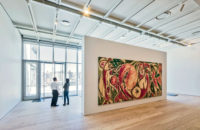The 140,000-square-foot museum is designed by the Finnish firm Lahdelma & Mahlamäki Architects. Just as the exhibitions will explore the Jewish experience in Poland from the Middle Ages, the architecture reaches far back for inspiration. The five-story cuboid volume features an organically-shaped incision through its entire depth that ranges in width from 23 feet to 39 feet. Architect Rainer Mahlamäki says that it references Moses’s parting of the Red Sea. The curved surfaces of this negative space will comprise prefabricated modules of sandstone-mixed concrete, providing contrast to the rigid geometry of the tempered-glass building shell.
Mahlamäki adds that the symbolism of the museum’s void “is very abstract, and you can see very universal forms in this design, too.” It also is strikingly analogous to Rappaport’s monument, in which a monolithic block of stone frames a central panel of bronze bas-relief figures. In a similar memorializing spirit, the museum’s 16,000-square-foot entry hall has been conceived as a pure architectural space—no visible exhibition content, ventilation, or technical devices—for contemplation.
The 2005 competition to design the Museum of the History Polish Jews was the first international architectural contest in Polish history and elicited 117 entries. Lahdelma & Mahlamäki’s concept trumped a shortlist that included Studio Daniel Libeskind, Peter Eisenman Architects, Kengo Kuma, and Zvi Hecker. The building broke ground in June and is scheduled to open in 2009.






